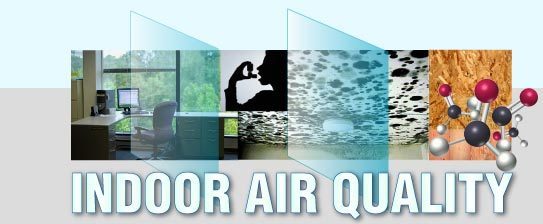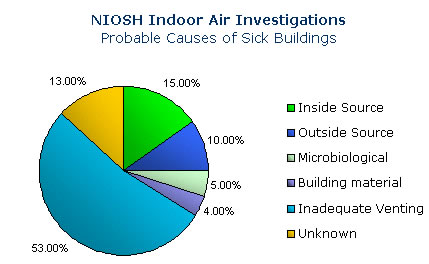Indoor Air Quality Assessments

The quality of indoor air inside offices, schools and other workplaces is important not only for workers' comfort but also for their health. Poor indoor air quality (IAQ) has been tied to symptoms like headaches, fatigue, trouble concentrating, and irritation of the eyes, nose, throat and lungs. However, many of these symptoms may also be caused by other health conditions including common colds or the flu, and are not necessarily due to poor air quality. This fact can make identifying and resolving IAQ problems more difficult.
Many factors affect IAQ. These factors include poor ventilation (lack of outside air), problems controlling temperature, high or low humidity, recent remodeling and other activities in or near a building that can affect the fresh air coming into the building. Sometimes, specific contaminants like dust from construction or renovation, mold, cleaning supplies, pesticides or other airborne chemicals (including small amounts of chemicals released as a gas over time) may cause poor IAQ.
Indoor air quality investigations completed by the National Institute of Occupational Safety and Health (NIOSH), found that most IAQ problems were found to result from:

This tells us that most indoor air quality situations can be evaluated by testing for the following:
- Carbon dioxide monitoring - Identifies inadequate ventilation. The most important parameter when testing IAQ is the carbon dioxide level. People exhale carbon dioxide and give off a mixture of chemicals. The carbon dioxide level can be used as an index of the occupancy loading of an area relative to the amount of ventilation provided that air. Carbon dioxide at levels that are unusually high indoors may cause occupants to grow drowsy, to get headaches or to function at lower activity levels.Professional bodies have developed guidelines for acceptable levels of carbon dioxide in an office or commercial building.
- Carbon monoxide monitoring - Carbon monoxide is a colourless, odourless, toxic gas. The presence of carbon monoxide can indicate contamination of the air by car emissions (escaping into fresh air ducting or open doors) or damaged/improperly operating equipment or machinery. Carbon monoxide can cause health problems before you even notice that it's present. At low levels, effects include flu-like symptoms, such as tiredness headaches shortness of breath and impaired motor functions.
- Temperature & Humidity - These levels are set using established guidelines such as the ASHRAE standard for Acceptable Indoor Air Quality. Please note that there is no specific legislation that deals with indoor air quality.
In some cases, more elaborate tests such as mold, duct particulate, radon, chemical, total volatile organic compound testing, etc. are used. However, it is not recommend that these tests be performed until there is a clear indication that they are needed. These types of tests can be extremely expensive and some are very time consuming and can take months to complete the testing. Most indoor air quality problems can be evaluated and resolved using relatively simple tests.
The right ventilation and building care can help prevent and fix indoor air quality problems. If you require indoor air quality testing in your classroom or building, please contact the divisional Safety Officer.


Please provide your question and email address in the fields below.
Your question has been successfully submitted.
CloseThank you.